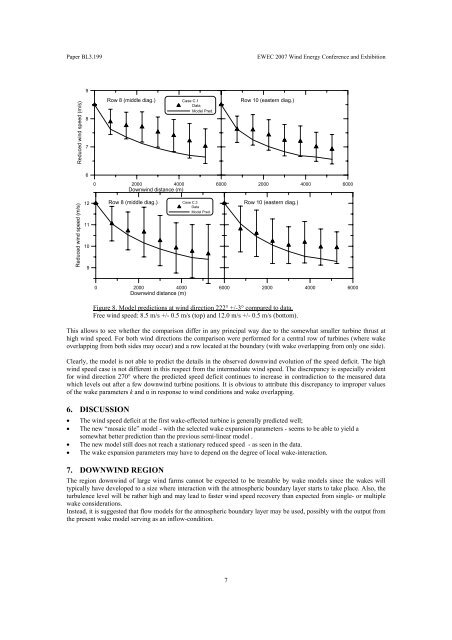BL3.199 Wake Modelling for intermediate and large wind farms
BL3.199 Wake Modelling for intermediate and large wind farms
BL3.199 Wake Modelling for intermediate and large wind farms
Create successful ePaper yourself
Turn your PDF publications into a flip-book with our unique Google optimized e-Paper software.
Paper <strong>BL3.199</strong><br />
EWEC 2007 Wind Energy Conference <strong>and</strong> Exhibition<br />
9<br />
Reduced <strong>wind</strong> speed (m/s)<br />
8<br />
7<br />
Row 8 (middle diag.)<br />
Case C.1<br />
Data<br />
Model Pred.<br />
Row 10 (eastern diag.)<br />
6<br />
0 2000 4000 6000<br />
Down<strong>wind</strong> distance (m)<br />
2000 4000 6000<br />
Reduced <strong>wind</strong> speed (m/s)<br />
12<br />
11<br />
10<br />
9<br />
Row 8 (middle diag.)<br />
Case C.3<br />
Data<br />
Model Pred.<br />
Row 10 (eastern diag.)<br />
0 2000 4000 6000<br />
Down<strong>wind</strong> distance (m)<br />
2000 4000 6000<br />
Figure 8. Model predictions at <strong>wind</strong> direction 222° +/-3° compared to data.<br />
Free <strong>wind</strong> speed: 8.5 m/s +/- 0.5 m/s (top) <strong>and</strong> 12.0 m/s +/- 0.5 m/s (bottom).<br />
This allows to see whether the comparison differ in any principal way due to the somewhat smaller turbine thrust at<br />
high <strong>wind</strong> speed. For both <strong>wind</strong> directions the comparison were per<strong>for</strong>med <strong>for</strong> a central row of turbines (where wake<br />
overlapping from both sides may occur) <strong>and</strong> a row located at the boundary (with wake overlapping from only one side).<br />
Clearly, the model is not able to predict the details in the observed down<strong>wind</strong> evolution of the speed deficit. The high<br />
<strong>wind</strong> speed case is not different in this respect from the <strong>intermediate</strong> <strong>wind</strong> speed. The discrepancy is especially evident<br />
<strong>for</strong> <strong>wind</strong> direction 270° where the predicted speed deficit continues to increase in contradiction to the measured data<br />
which levels out after a few down<strong>wind</strong> turbine positions. It is obvious to attribute this discrepancy to improper values<br />
of the wake parameters k <strong>and</strong> α in response to <strong>wind</strong> conditions <strong>and</strong> wake overlapping.<br />
6. DISCUSSION<br />
• The <strong>wind</strong> speed deficit at the first wake-effected turbine is generally predicted well;<br />
• The new “mosaic tile” model - with the selected wake expansion parameters - seems to be able to yield a<br />
somewhat better prediction than the previous semi-linear model .<br />
• The new model still does not reach a stationary reduced speed - as seen in the data.<br />
• The wake expansion parameters may have to depend on the degree of local wake-interaction.<br />
7. DOWNWIND REGION<br />
The region down<strong>wind</strong> of <strong>large</strong> <strong>wind</strong> <strong>farms</strong> cannot be expected to be treatable by wake models since the wakes will<br />
typically have developed to a size where interaction with the atmospheric boundary layer starts to take place. Also, the<br />
turbulence level will be rather high <strong>and</strong> may lead to faster <strong>wind</strong> speed recovery than expected from single- or multiple<br />
wake considerations.<br />
Instead, it is suggested that flow models <strong>for</strong> the atmospheric boundary layer may be used, possibly with the output from<br />
the present wake model serving as an inflow-condition.<br />
7
















